This is a Veteran Owned site

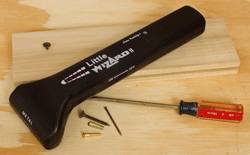 |
The Little Wizard II is very simple to use but effective. Click image to enlarge |
Little Wizard II
Finding what you can't see
Text, photos and video by Tom Hintz
Posted - 12-26-2008
Nothing can ruin a day in the shop like running an unseen chunk of metal through a jointer, planer or saw. The resulting damage can be frustrating, expensive and potentially dangerous. Because wood comes from trees that stood unguarded from people that might insert bullets, nails, screws, staples and who-knows-what into them, discovering hidden metal is not uncommon. It should also not be unexpected. Before the age of electronics the problem was that unless the metal was clearly visible, the first indication of its presence was often contact with a spinning cutter. That means things have already gone very wrong.
Simple Wizardry
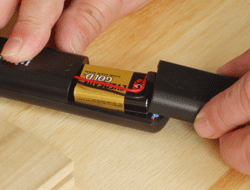 |
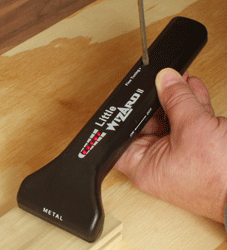 |
Setting up the Little Wizard II is a matter of installing a battery (left) and tweaking its fine-tuning (right) to set it for the environment. Click images to enlarge |
|
The folks at Wizard Industries, Inc have made life easier for those of us lacking x-ray vision or never-ending blind luck. Their Little Wizard II is an economical bit of electronics that sees where we can't see. And, they packed this wondrous capability into a hand-sized tool that is both easy to use and store regardless of shop size. At a trim 5.7-oz, (including the 9-volt battery) using the Little Wizard II is not a test of strength.
The Wizard folks also kept operation simple for us. To get the Little Wizard II working you only need to install a 9-volt battery (not included) and go through a very simple fine-tuning procedure meant to acclimate it to your shop environment. A twist or two with a small screwdriver is all it takes. The next most complicated task is finding is finding the piece of wood you wanted to scan.
Scanning
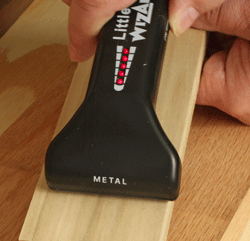 |
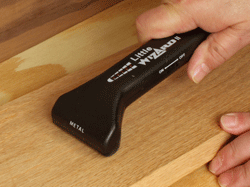 |
The 2"-wide head makes short work of narrow wood (left) but on bigger pieces, (right) using a circular, over-lapping motion helps to make sure you don't miss anything. Click images to enlarge |
|
The Little Wizard II has a 2"-wide (approximately) scan beam so multiple passes may be needed. Wizard recommends using an overlapping circular pattern to be sure all of the wood is adequately searched. They also recommend scanning all four sides of wood over 3/4"-thick for the best coverage. They also suggest scanning between cuts on machines such as planers that remove a layer of wood to be sure a small piece of metal has not been revealed.
The Little Wizard II alerts you to metal with an audible tone and a line of LED lights that grows longer as you get closer to the metal. The line of lights helps you pinpoint where the metal is which is helpful when it is buried.
In the Shop
Video Tour |
The good (and bad) news is that if using the Little Wizard II is very simple. However, if it seems complicated, virtually everything else in a woodworking shop is far too dangerous for you to be around. For most of us the biggest challenge will be forcing ourselves to take the minute or two necessary to use it. Remembering where you left it might be a close second.
As you can see in the accompanying video, setup of the Little Wizard II takes seconds. There is no complicated calibration, just a quick fine tuning that may have to be repeated if the shop environment (weather) changes significantly. The Little Wizard II literature (and my experience) suggests that when the weather changes significantly, particularly humidity, the Little Wizard II might need a little tweak to its fine-tuning.
In use, the Little Wizard II does a very good job of picking out metal whether it is on the surface or a little below. If you scan wood most board stock from both sides, it is unlikely that bits of metal will escape you. I was able to find very fine 1/2"-long screws and 3/8"-long staples from the opposite side of 1"-thick oak with no trouble. It seems that the Little Wizard II is best at depths up to 1/2" in most woods.
Wizard warns that wet wood is more difficult to detect metal in. I soaked a piece of 1"-thick oak with water and the Little Wizard II did have trouble finding metal. Of course, I would never work with wood that wet anyway so when it dries out to a more reasonable level, the Little Wizard II works fine.
Conclusions
The Little Wizard II is at $19.99 (12-26-2008) a very cheap way to protect your expensive jointer and planer knives as well as plane irons and saw blades. It does not have the power (depth) and wide beam like its big (and more expensive) brother the Lumber Wizard III but used correctly, the Little Wizard II will scan your wood far quicker than you can fix a damaged tool, and for way less. If you are not currently scanning your wood for metal, the odds are stacking up against you. Tick Tock.......
Visit the Wizard Detector web site - Click Here
Have a comment on this review? - Email Me!
Back to the Tool Reviews List.
All written, photographic and drawn materials are property of and copyright by NewWoodworker.com LLC 2000-2019. Materials may not be used in any way without the written permission of the owner.

